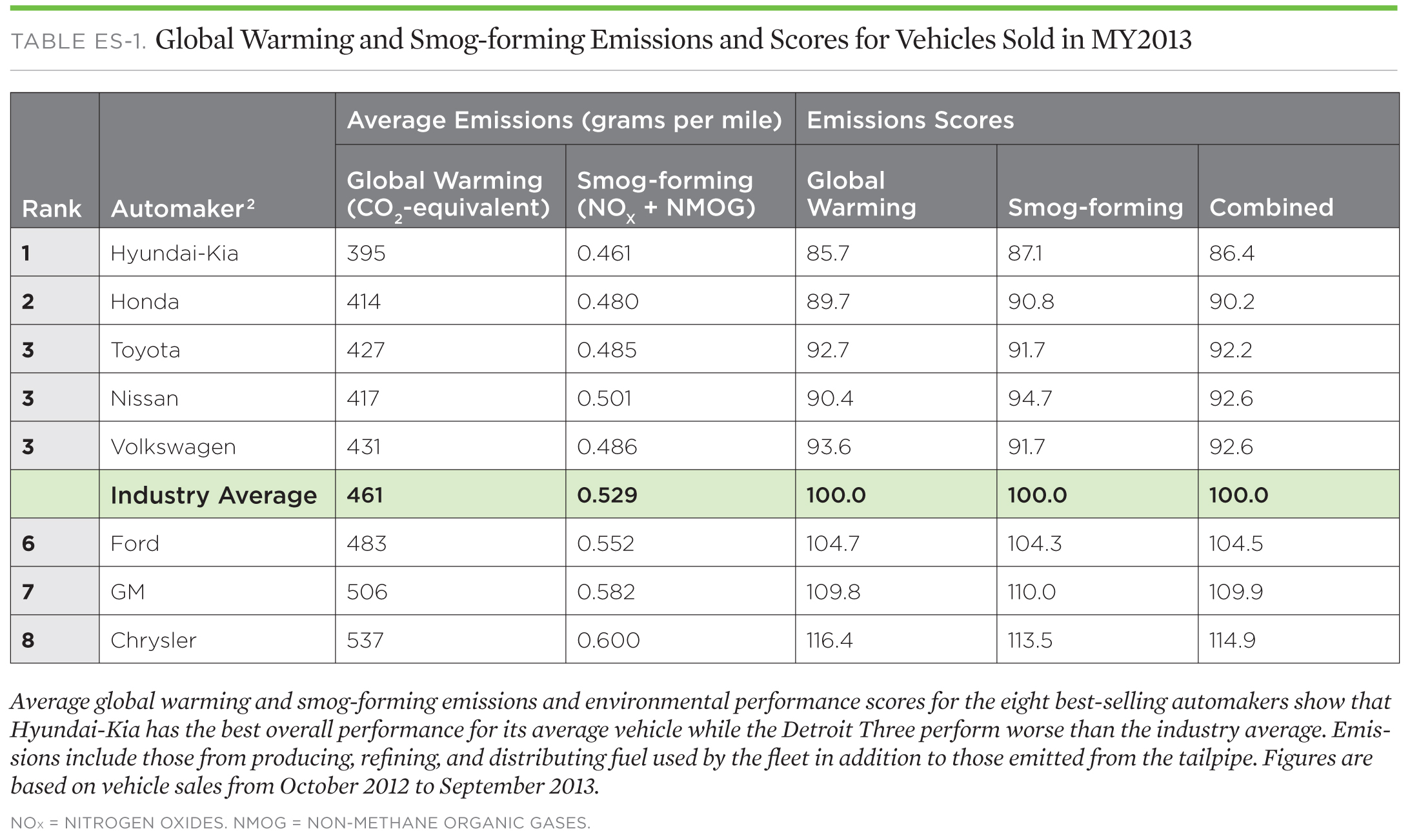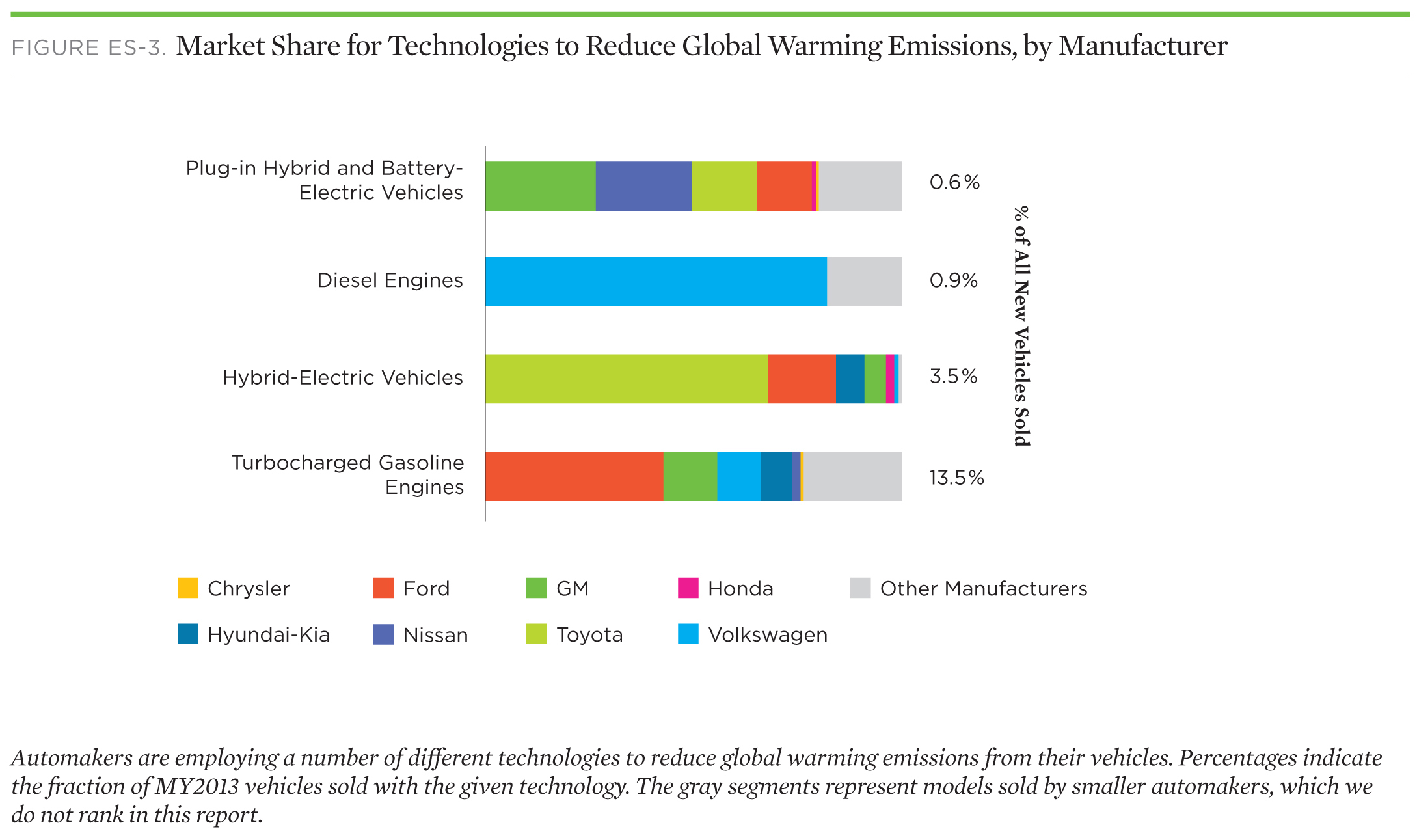Today, UCS releases our latest Automaker Rankings report, which analyzes new passenger cars and trucks from the 2013 model year. For the first time, our analysis shows that all 8 top-selling automakers have now reduced the global warming emissions from their average vehicle sold when compared to our first report, which looked at 1998 vehicles. In addition, tailpipe emissions of smog-forming pollutants from the average vehicle have decreased by 87% since 2000. This shows that the standards we at UCS have advocated so strongly for are working.
Who is the Greenest Automaker?
With the release of Automaker Rankings 2014, we also announce the newest “Greenest Automaker.” In another first, Hyundai-Kia has been awarded the crown, toppling Honda for the first time since we began these rankings. Using the adjusted, most up-to-date information on Hyundai-Kia’s vehicles after the automaker had to revise its performance data with the EPA, our analysis shows that a concerted effort to improve the fuel efficiency across its fleet—and therefore reduce its global warming emissions—enabled Hyundai-Kia to pass Honda. To do this, Hyundai-Kia replaced the engines used in a number of models with smaller and more efficient turbocharged engines and also introduced hybrid-electric versions of two of its top-selling vehicles, the Hyundai Sonata and Kia Optima.
Who has the dirtiest tailpipe?
Unfortunately, not all manufacturers are showing the same leadership on improving their environmental performance. As with every Automaker Rankings to date, the Detroit Three fall at the back of the pack, performing worse than the industry average. And finishing in last place is Chrysler, who has earned the “dirtiest tailpipe” distinction in all but one of our analyses.
But not all is doom and gloom for the domestic automakers—Ford has made big strides and is beginning to pull away from its truck-heavy counterparts, thanks to both its leadership in turbocharging and downsizing its engines as well as a developing hybrid rivalry with Toyota. Its smaller engines can be found in vehicles ranging from the top-selling vehicle on the road, the F-150 pick-up, all the way down to its smallest vehicles, proving that fuel economy can be improved in all vehicle classes, even trucks. And 1 in 10 of the cars Ford now sells are hybrid models.
How are manufacturers making a difference?
As this chart shows, each automaker is taking a different approach to cleaning up its fleet—and this is good news, as it demonstrates how many different pathways to progress are possible. As mentioned above, using a turbocharger can provide a boost in power, allowing manufacturers to draw the same level of performance out of a smaller, more efficient engine. While turbochargers have been used for years to provide a sporty boost in torque, manufacturers like Ford are now using this technology to improve fuel economy.
Additionally, diesels and hybrids also provide opportunity for reductions in global warming emissions but as of now represent very small fractions of the fleet. While the share of plug-in electric vehicles has been growing, these highly efficient vehicles currently represent an even smaller fraction of new vehicle sales than either diesels or hybrids, which leaves plenty of further opportunity for growth in this segment. Expanding the use of these and other technologies moving forward will allow manufacturers plenty of flexibility to meet fuel economy and global warming emission standards in the coming years.
What comes next?
Our analysis shows that the industry has made tremendous progress in reducing its environmental impact and providing cleaner options to consumers across all vehicle classes, turning a corner on global warming emissions and tailpipe smog-forming emissions. As new Tier 3 tailpipe emission standards begin to take effect in 2017, we can expect even more declines in smog-forming emissions from the U.S. fleet. And as more stringent fuel economy and greenhouse gas emissions standards continue to take effect, we expect the downward trend to continue on global warming emissions as well. Diverse strategies to improve fuel economy and global warming emissions—from improvements in conventional engines to plug-in electric and hybrid-electric vehicles—attest to opportunities for automakers to do much more as we move to halve our projected oil use.
For the whole story, please check out the full report, as well as this nifty infographic to share with your friends!


